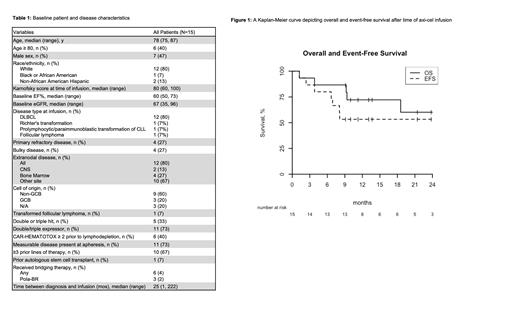Background
The treatment of older patients with relapsed/refractory (R/R) aggressive non-Hodgkin B-cell lymphomas (NHL) remains a significant clinical challenge. Chimeric antigen receptor T-cell (CAR-T) therapy represents a potentially curative option, but elderly patients remain underrepresented in relevant clinical trials, and less is known about the safety of CAR-T among patients older than 75 years. Toxicities including cytokine release syndrome (CRS), neurotoxicity (ICANS), arrhythmias, renal failure, and cytopenias may pose higher risk in elderly patients with comorbidities and decreased physiologic reserve compared to younger CAR-T recipients. We sought to characterize outcomes and toxicities of axicabtagene ciloleucel (axi-cel) in a cohort of patients aged ≥ 75 years.
Methods
This was a retrospective analysis of consecutive patients aged ≥ 75 years with R/R NHL who received axi-cel at New York-Presbyterian/Weill Cornell Medical Center. Data collected included patient characteristics and outcomes including response rates, event-free and overall survival, rates of CRS, ICANS, arrhythmias and severe cytopenias, and length of hospital stay. CRS and ICANS severity were graded following the ASTCT consensus criteria. Cytopenias were graded as per NCI-CTCAE v5.0. Event free survival (EFS) was defined as time to disease progression or death.
Results
We identified 15 patients with a median age of 78 (range 75-87) years; 6 (40%) were ≥ 80 years of age. 14 patients had a diagnosis of large B-cell lymphoma and 1 had multiply relapsed follicular lymphoma. Ten patients (67%) had received 3 or more prior lines of therapy. Additional baseline characteristics are summarized in Table 1.
Among 10 patients (67%) who developed CRS of any grade, only 1 (7%) experienced grade ≥3 CRS; this CRS event was fatal. Five (33%) patients developed ICANS with only 1 patient (7%) developing grade ≥3 ICANS. Two (13%) patients and 10 (67%) patients developed grades 3 and 4 cytopenias within 30 days of infusion, respectively. Four (27%) patients required blood or platelet transfusions within 100 days of infusion. Febrile neutropenia was seen in 8 (53%) patients, and 8 patients had culture or PCR-verified bacterial (33%), viral (40%), or fungal (7%) infections. Only 1 (7%) patient developed a new abnormality on EKG within 30 days of infusion (right ventricular conduction delay).
Median length of inpatient stay was 17 days (range 13-35), and 2 (13%) required re-hospitalization within 100 days of infusion. Overall and complete response rates at 100 days post-infusion were 13 (86%) and 11 (73%), respectively. At one year, overall and event-free survival were 72.2% (95% CI: 54.4-99.6%) and 53.3% (95% CI: 33.2%-85.6%), respectively. The median overall survival was 30.8 months with a median follow-up of 21.4 months. One patient experienced treatment-related mortality due to CRS, and 5 (33%) had subsequent disease relapse.
Conclusion
These results suggest that axi-cel is an effective and well-tolerated treatment for patients age ≥ 75 with R/R NHL. Only 1/15 patients developed grade ≥3 CRS or ICANS which is comparable to reported rates of toxicities in younger patients. Although multiple studies have identified cytopenias and cardiac arrhythmias as major CAR-T toxicities, a minority of our cohort required transfusions, and none developed life-threatening arrhythmias. OS and EFS were also comparable to real-world experience seen in younger patients. This study may be limited by the selection of a relatively fit population of elderly patients; however, the median Karnofsky Performance Score was 80 and ranged as low as 60. Overall, these findings show that axi-cel may be an appropriate strategy for relapsed aggressive NHL in carefully selected patients in their eighth and even ninth decades of life.
Disclosures
No relevant conflicts of interest to declare.


This feature is available to Subscribers Only
Sign In or Create an Account Close Modal